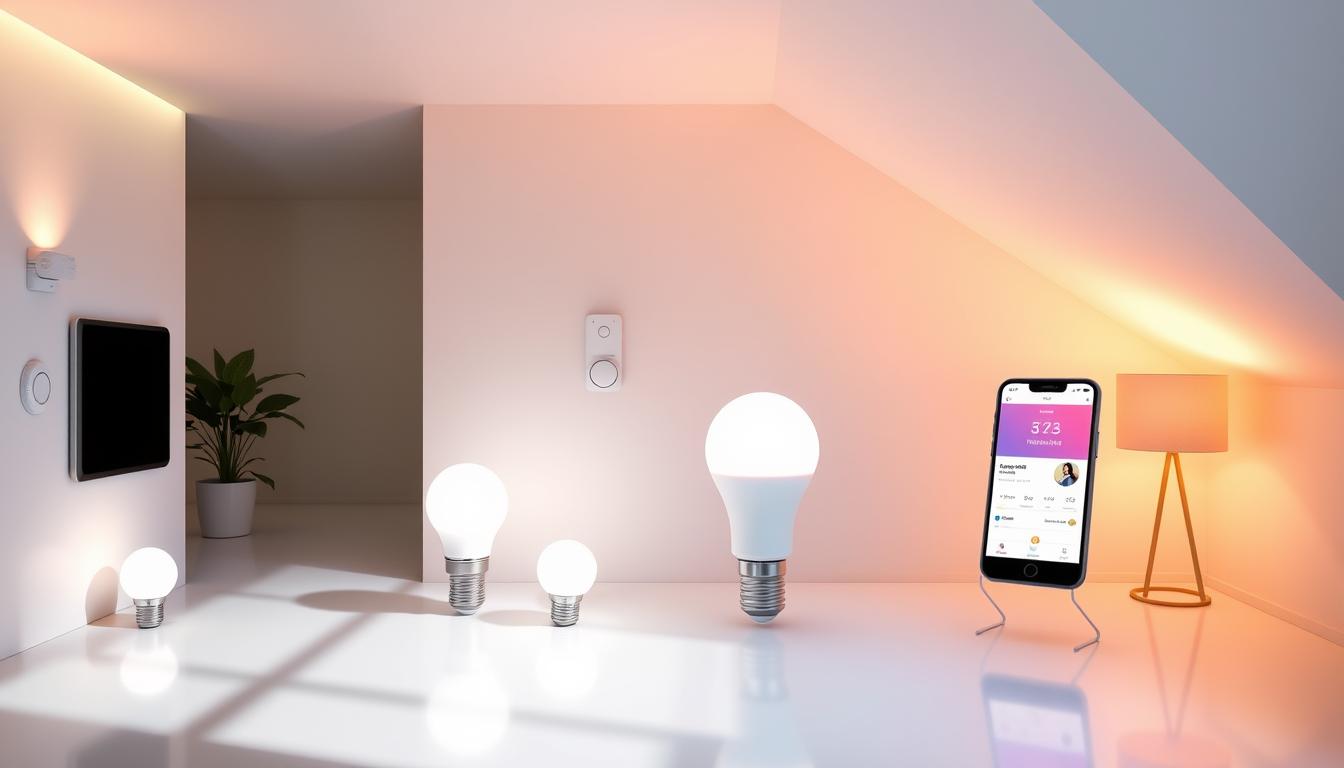Lighting automation and control systems have evolved a lot. They now change how we use and enjoy light every day. With new tech, these systems offer many features and benefits.
In today’s homes and offices, smart lighting is key. It improves ambiance, boosts productivity, and saves energy. With control systems, you can easily adjust your lighting to fit your needs. This makes smart spaces even better.
Exploring smart light controls shows how important they are. They make our lives easier and more convenient. From simple to complex systems, there’s a lot to discover. Knowing about control systems is important, whether you’re updating your lighting or setting up a new space.
Key Takeaways
- Lighting automation enhances ambiance and productivity
- Control systems offer customizable lighting solutions
- Energy efficiency is a significant benefit of smart light controls
- Advanced systems provide seamless integration with other smart devices
- Understanding control systems is crucial for creating a smart space
- Lighting automation and control systems have numerous benefits for homes and offices
Understanding the Basics of Light Control Systems
Light control systems are key in today’s homes and offices. They offer many benefits like better convenience, energy use, and mood. These systems let users set lighting scenes and schedules for different times and activities.
Smart light systems learn and adjust to what users like. They use sensors and controllers for a smooth experience. By setting scenes and schedules, users make their space more comfy and productive.
What Makes a Light Control System “Smart”
A smart light system connects with other smart devices. This makes it easy to control lighting, temperature, and security from one place. It helps users manage their space better and save energy.
Key Components and Technologies
Smart light systems have sensors, controllers, and communication tech. These parts work together for features like scene setting and scheduling. They help users create lighting that improves their daily life.
Benefits of Smart Lighting
Smart lighting offers many advantages. It saves energy and money, and makes life easier and more enjoyable. By setting scenes and schedules, users can make their space perfect for any time or activity.
| Benefits | Description |
|---|---|
| Energy Efficiency | Smart lighting systems can help reduce energy consumption by optimizing lighting usage and adjusting to natural light levels. |
| Convenience | Smart lighting systems can be controlled remotely, allowing users to adjust their lighting from anywhere in the world. |
| Ambiance | Smart lighting systems can create customized lighting experiences that enhance the ambiance of a room or space. |
Types of Smart Light Controls Available Today
There are many smart light control options to fit various needs and tastes. One big plus is the remote access feature. This lets users control their lights from anywhere. This is thanks to technologies like Wi-Fi, Bluetooth, and Zigbee.
Popular smart light controls include wireless and wired systems. Wireless systems are easy to install and offer flexibility. Wired systems, on the other hand, provide a stable connection.
When picking a smart light control system, consider these important features:
- Compatibility with existing lighting fixtures
- Ease of installation and setup
- Remote access capabilities
- Energy efficiency and cost savings
- Integration with other smart home devices
By looking at these points and the different smart light controls out there, users can make smart choices. They can enjoy the perks of remote access and other advanced features.
| System Type | Key Features | Benefits |
|---|---|---|
| Wireless | Ease of installation, flexibility | Convenience, cost-effective |
| Wired | Reliable connection, security | Peace of mind, energy efficiency |
Essential Features of Modern Light Control Systems
Modern light control systems bring comfort, energy savings, and convenience together. They work in harmony to make homes and offices better and greener.
Motion detection and occupancy sensing are key. They turn lights on and off when someone enters or leaves a room. This saves energy and connects well with other smart devices.
Motion Detection and Occupancy Sensing
Motion detection and occupancy sensing are vital. They use sensors to turn lights on and off. This saves energy and makes life easier.
Dimming Capabilities
Dimming is another important feature. It lets users change light brightness. This feature works well with other smart devices.
Color Temperature Adjustment
Color temperature adjustment lets users change light colors. This feature adds comfort and convenience, working well with other smart devices.
These features together make life better. They save energy and make spaces more enjoyable. By using these features, homes and offices become more sustainable and comfortable.
| Feature | Description |
|---|---|
| Motion Detection | Automatically turns lights on and off based on room occupancy |
| Dimming Capabilities | Allows users to adjust the brightness of lights to suit their needs |
| Color Temperature Adjustment | Allows users to adjust the color temperature of lights to suit their needs |
Setting Up Your Smart Light Control Network
To make your smart lighting system work well, you need to set up lighting zones. This means dividing your space into areas with their own lighting needs. This way, you can control the lights in each area separately, making your smart lighting system more useful.
A good lighting zone plan helps you create the right mood for any activity or event. For example, you can make your living room cozy by changing the light levels and colors in that zone. Here’s how to begin:
- Find the different spots in your space that need special lighting setups
- Figure out what lighting each area needs, like the type and how bright
- Choose a specific lighting zone for each area, so you can control the lights there alone
By organizing your smart light control network with lighting zones
| Zone | Lighting Requirements | Control Options |
|---|---|---|
| Living Room | Cozy ambiance, adjustable brightness | Dimming, color temperature adjustment |
| Kitchen | Bright, task-oriented lighting | High-brightness setting, motion detection |
| Bedroom | Soft, relaxing lighting | Dimming, scheduling, geofencing |
With a smart lighting zone setup, you can get the most out of your smart lighting system. You’ll enjoy a more comfortable, convenient, and energy-saving home.
Advanced Automation and Scene Creation
Smart light control systems offer advanced automation. This lets users create personalized lighting experiences. They can set up different scenes for various activities or moods.
For instance, a “relax” scene might dim the lights and change the color temperature. This creates a calming atmosphere.
Lighting automation allows for custom scenes. Users can use schedule-based controls to set scenes for specific times. Geofencing also adjusts lighting when entering or leaving a certain area.
- Customizable lighting scenes
- Schedule-based controls
- Geofencing and location-based automation
These features help users create tailored lighting scenarios. They make lighting more comfortable, convenient, and energy-efficient.
With smart light control systems, users can create a wide range of custom lighting scenes. This includes a “movie night” scene that dims the lights and adjusts the color temperature. It also includes a “work” scene that brightens the lights and improves focus.
Integration with Smart Home Ecosystems
Smart light controls can connect with many smart home systems. This makes your home smarter and more efficient. It brings everything together for a better experience.
With this integration, you can control lights, temperature, and security easily. For instance, smart home hubs link different devices. This makes controlling and automating your home simple.
Compatible Platforms and Protocols
Platforms like Apple HomeKit and Google Home work with smart lights. They use Zigbee and Z-Wave to talk to devices.
Voice Control Options
Voice assistants like Amazon Alexa and Google Assistant control lights. This hands-free option is great for busy homes. It lets you manage many devices with your voice.
Third-Party App Integration
Smart lights also work with apps like IFTTT and SmartThings. These apps add more features and automation. They make your smart home even better.
Smart light controls make your home more convenient and efficient. With compatible platforms, voice control, and app integration, your home becomes smarter. It’s a step up in smart living.
Energy Efficiency and Cost Savings
Smart light controls are great for saving energy and money. They use scheduling to turn lights on and off at set times. This cuts down on energy use. Plus, remote access lets users control lights from anywhere, preventing waste.
Smart light controls bring many benefits, including:
- Less energy use
- Lower bills
- Longer life for lights
Studies show smart lights can cut energy use by up to 20%. This is thanks to tech like motion and occupancy sensors. They make sure lights are only on when someone’s there.
Getting smart light controls is a smart move. It helps save energy and supports a greener planet. Users can control and check their lights from anywhere. This lets them use energy wisely and make changes when needed.
Troubleshooting Common Light Control Issues
Smart light controls need troubleshooting to work well. Problems can affect your lighting zones and smart integration. We’ve made a guide to fix common issues and get your system working again.
Common issues include connectivity problems. These can be due to bad internet or faulty hardware. System responsiveness is also key. A slow system can be annoying. Regular updates and maintenance keep your system running smoothly.
Identifying and Resolving Issues
To fix problems, first check your internet and device connections. Try restarting or updating your software. For tougher issues, look at the user manual or contact support.
By following these steps and keeping up with maintenance, your smart light system will work great. It will control your lighting zones well and fit with your smart home. With some troubleshooting skills, you’ll enjoy a well-lit home and smart integration benefits.
Security Features and Remote Access
Security is a big deal in smart light control systems. They offer remote access to control lights from anywhere. This is thanks to strong control systems that keep user data safe and block unauthorized access.
Smart light systems use top-notch encryption and secure communication. This keeps data safe from hackers. Some even have two-factor authentication for extra security.
- Automatic software updates to keep the system safe and current
- Secure data storage to protect user info and settings
- Advanced threat detection to catch and stop security threats
With secure remote access and these features, users can relax. They know their system is safe and easy to use.
| Security Feature | Description |
|---|---|
| Encryption | Protects data sent between the user’s device and the control system |
| Two-Factor Authentication | Provides an extra security step to block unauthorized access |
| Automatic Software Updates | Makes sure the system is always secure and updated |
Comparing Popular Smart Light Control Brands
Many brands offer smart light control solutions, making it hard to pick the best one. It’s key to compare popular brands. Look at their entry-level and professional systems, and how much you get for your money. This will show you the differences in features like lighting automation, scene setting, and scheduling.
Some brands, like Philips Hue and LIFX, let you control lights from afar and set schedules. They also have scene setting for different times. Belkin and TP-Link let you schedule your lights to fit your daily life.
- Entry-level solutions: Look for brands that offer affordable and easy-to-use systems, such as Philips Hue and LIFX.
- Professional-grade systems: Consider brands like Control4 and Savant, which offer advanced features and integration with other smart home devices.
- Price-to-feature analysis: Evaluate the cost of each system and compare it to the features and benefits offered.
By looking at these points and comparing brands, you can make a smart choice. You’ll find a system that fits your needs and budget. It will give you the convenience of lighting automation, scene setting, and scheduling.
Conclusion: Choosing the Right Smart Light Control System for Your Needs
Starting your smart lighting journey is exciting. The key is to pick a system that fits your home perfectly. It should be easy to control and save energy.
Think about what you need, like how many rooms you have and what features you want. Look at top brands and read what others say. This helps you find something that fits your budget and your level of tech know-how.
Choose a system that makes your home more comfortable and saves energy. With careful planning, you can make your home smart and adaptable to your life.


